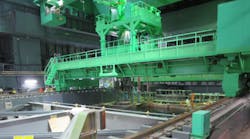FUKUSHIM DAIICHI NUCLEAR PLANT, Japan — The chief of Japan’s shuttered Fukushima nuclear power plant warned Wednesday that the biggest risk the crippled facility faces is another major earthquake and tsunami — though he insisted the chaos of nearly five years ago won’t be repeated.
On March 11, 2011, a magnitude 9.0 undersea earthquake off Japan’s northeastern coast sparked a massive tsunami that swamped cooling systems and triggered reactor meltdowns at the Fukushima Daiichi plant, run by operator Tokyo Electric Power (TEPCO).
Radiation spread over a wide area and forced tens of thousands of people from their homes — many of whom will likely never return — in the worst nuclear accident since Chernobyl in 1986.
Now, with the fifth anniversary of the disaster approaching, TEPCO opened up the facility to journalists to provide an update on the clean-up process, which is expected to take decades.
“If a major earthquake hits and then a tsunami comes again, that would be the most tense moment for us,” Akira Ono, head of the plant, told reporters when asked what would be the greatest risk to the plant.
TEPCO has been blamed for a delay in securing power to cool fuel in the reactors that triggered meltdowns and subsequent hydrogen explosions that spewed radiation over the area and forced residents to flee.
“But we will not fall into similar confusion like before,” Ono said, explaining that energy levels at the plant are much lower than those after the accident, while the company has carried out disaster drills to prepare.
He also said the firm had built temporary coastal barriers that can block waves of up to 50 feet, matching levels of the 2011 tsunami.
Some 8,000 workers, ranging from nuclear experts to civil engineers, are still battling daily to control the meltdown-hit reactors as their decommissioning process is in its initial stage.
Challenges Ahead
Some progress has been made as massive wreckage, including overturned vehicles, were removed and workers are no longer required to wear full-face masks in many areas of the site. In a newly built rest station inside the facility, workers can have hot meals and check their radiation exposure levels through state-of-art whole-body counters.
But the scar of the catastrophe is still visible in other areas as steel frames gnarled by the hydrogen explosions can be seen at the plant’s No. 3 reactor, where radiation levels are still extremely high.
About 1,000 huge tanks for storing contaminated cooling water occupy large parts of the site about 140 miles northeast of Tokyo. And more tanks will be needed as massive amounts of groundwater flow into the reactors ever yday and mixes with the cooling water.
Ono says the reactors are now stable but need to be kept cool to prevent them running out of control again. TEPCO estimates that it is likely to take up to four decades to completely clean up the site, but some experts warn the unprecedented decommissioning might be delayed further.
“I feel like we have just climbed over the first stage of a mountain,” Ono said, using a colloquial Japanese expression, meaning that only 10% of the journey is finished.
By Shingo Ito
Copyright Agence France-Presse, 2016



